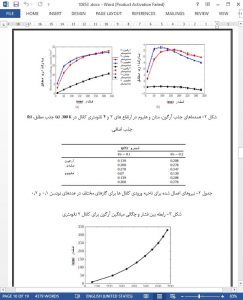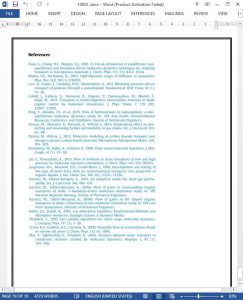Abstract
The objective for this work is to investigate the contribution of the adsorbed phase to the mass flux and comparing transport of gases with different adsorption affinities in organic nano-scale channels. In this work, force-driven Non-Equilibrium molecular dynamics (NEMD) simulations are used to compare the transport of gases with high adsorption affinity (Methane and Argon) with the ones with low adsorption affinity (Helium), for channel heights of 2, 4, 6, and 8 nm at two Knudsen numbers of 0.1 and 0.2. Velocity and mass flux profiles across the channel for Argon, Methane, and Helium are compared. Transport diffusion coefficients and molecular flux of these gas are also calculated. Furthermore, adsorption properties are analysed using Grand Canonical Monte Carlo simulations.
For all the gases studied, plug-shaped velocity profiles are observed irrespective of the channel size and Knudsen number. Mass flux profiles of Argon and Methane across the channels demonstrate a significant contribution of adsorbed molecules to the total mass flux. Furthermore, as Knudsen number increases, the contribution of the adsorbed phase to the total mass flux becomes higher. Molecular flux of Helium is smaller than that of Argon and Methane for all channel sizes. The calculated diffusion coefficients of Methane are higher than those for Argon for all the channel sizes and they decrease as the channel size increases. For Argon and Methane, the diffusion coefficients become smaller as Knudsen number increases. For Helium, the diffusion coefficients are weak functions of the channel size and Knudsen number. Based on the results, contribution of the adsorbed molecules can be more than 50% of the total mass flux of the channel. For the pressure ranges studies, transport diffusivity of Helium is less sensitive to pressure and Knudsen number compared to Argon and Methane.
This study shows that the transport through organic nano-scale conduits is essentially diffusive. Therefore, to have a realistic model for predicting the recovery of fluids from unconventional resources, the transport equations in organic nanopores should be replaced by the diffusive transport equations.
1. Introduction
Gas recovery mechanisms from shale resources are different from those of conventional resources due to presence of organic nanopores. In one hand, the gas molecules have a tendency to be adsorbed to the surfaces of the organic pores that results in heterogeneous fluid distributions within the pores. Adsorption of gas molecules to the pore surfaces causes molecular level transport effects, such as surface-diffusion. On the other hand, the pore sizes are comparable to the mean free path of the molecules, which causes non-continuum flow regimes. The transport of fluids in this systems cannot be described by classical continuum-based hydrodynamic equations. A question then arises as to how different is the transport of gases with low adsorption affinity, e.g., Helium, compared to the ones with high adsorption affinities, e.g., Methane and Argon, in organic nano-scale conduits? Answer to this question can enhance our understanding of the fluid transport mechanisms in shale resources.
4. Conclusions
Adsorption and force-driven transport of Helium, Argon, and Methane in four graphite channels of 2, 4, 6, and 8 nm hight is studied by performing GCMC and NEMD simulations. Methane and Argon show similar adsorption behavior (absolute and excess adsorptions) while the density of Helium across the channel height is approximately constant.
For all gases, whether the adsorption affinity is high (Argon and Methane) or low (Helium), plug-shaped velocity profiles are established for all the channel heights. Therefore, due to the higher adsorbed density values of the Argon and Methane, the adsorbed phase contribute significantly to the overall mass flux across the channel. Mass flux profiles of Argon and Methane across the channels demonstrate a significant contribution of adsorbed molecules to total mass flux. According to these results, as Knudsen number increases, the contribution of the adsorbed phase transport to the total mass flux of the channels becomes higher. This contribution is 42% for Argon and Methane at Knudsen number of 0.1, which increases to approximately 53% at Knudsen number of 0.2.











